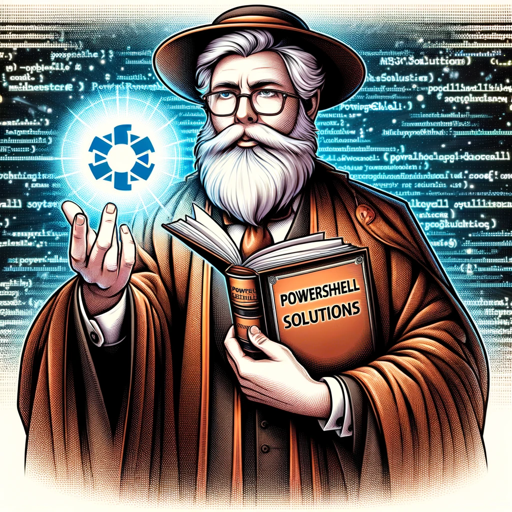AMO Co-pilot-AI-powered AMO physics assistant
AI-powered insights for AMO research
Explain the concept of quantum entanglement.
What are the latest trends in AMO physics?
Suggest resources for studying laser cooling.
How does atomic absorption spectroscopy work?
Related Tools
Load More
Research Co-pilot
An assistant for all you research needs
EPB CoPilot
Guides USAF Airmen in EPB document creation, utilizing provided military resources.

MS Co-Pilot
Guide for Microsoft Graph API and OAuth configuration.

Autopilot
A tiny GPT you can @ to put whatever you were doing on autopilot

Product Manager Copilot
Assistant for Product Managers / Product Owners in building products customers love.

Copilot Pro
He look for bugs in the code and refactor it.
20.0 / 5 (200 votes)
Introduction to AMO Co-pilot
AMO Co-pilot is designed to assist researchers, students, and professionals working in Atomic, Molecular, and Optical (AMO) physics. Its primary role is to serve as a research assistant, capable of handling advanced topics like Bose-Einstein condensates, laser cooling, and quantum optics, while also drawing on specific knowledge of key atomic systems such as Rubidium-87 and Cesium. By leveraging sources like 'Advances in Atomic Physics' by Cohen-Tannoudji and Guéry-Odelin, 'Classical and Modern Optics' by Steck, and 'Quantum Electronics for Atomic Physics' by Nagourney, it helps users quickly access reliable scientific data, theoretical frameworks, and experimental methods. AMO Co-pilot offers insights into physical properties, such as those related to Rubidium-87 atoms, and aids in understanding concepts like hyperfine structure and optical pumping. For example, in a scenario involving laser cooling of Rubidium-87, AMO Co-pilot can provide essential details like resonance frequencies, recoil energy, and Doppler cooling limits, making it easier for researchers to design experiments.

Main Functions of AMO Co-pilot
Information Retrieval
Example
Researchers working with Rubidium-87 atoms need data on the D2 line transition frequency. AMO Co-pilot provides this information instantly from resources like Steck's 'Rubidium 87 D Line Data'.
Scenario
A physicist planning an experiment involving optical molasses can quickly access the natural linewidth, oscillator strength, and recoil temperature of Rubidium-87 to fine-tune the setup.
Concept Explanation
Example
AMO Co-pilot explains complex concepts such as hyperfine splitting and the Zeeman effect in a simple, structured format, tailored to the user's needs.
Scenario
A graduate student studying the interaction of Rubidium-87 with magnetic fields asks for a detailed explanation of the Breit-Rabi formula and how it affects clock transitions in atomic fountains.
Experimental Design Assistance
Example
AMO Co-pilot can provide guidelines on laser cooling parameters, such as calculating the Doppler and recoil temperatures of Rubidium-87 using well-known formulas.
Scenario
An experimental physicist wants to cool Rubidium-87 atoms below the Doppler limit using sub-Doppler cooling techniques. AMO Co-pilot offers guidance on achievable temperatures and beam configurations.
Ideal Users of AMO Co-pilot
AMO Physicists and Researchers
Researchers focused on quantum optics, laser cooling, and precision measurement experiments. These users benefit from quick access to detailed atomic data, like the hyperfine structure of Rubidium-87, and guidance on experimental setups involving Bose-Einstein condensates or magneto-optical traps.
Graduate Students in Physics
Graduate students working on advanced topics in AMO physics, such as quantum electronics or atomic clocks, gain from clear explanations of complex theories and assistance with the design and analysis of experiments involving atoms like Cesium and Rubidium.

How to Use AMO Co-pilot
Visit aichatonline.org for a free trial without login.
Access the platform without needing a ChatGPT Plus subscription or login, allowing you to explore the tool's features instantly.
Prepare your research question or materials.
Have your AMO physics-related questions, datasets, or documents ready to maximize productivity during the session.
Upload relevant files if needed.
Use the file upload feature to share any documents that need analysis, such as scientific papers or data related to Atomic, Molecular, and Optical physics.
Ask for detailed explanations or analyses.
Input specific queries related to Bose-Einstein condensates, Rubidium-87 properties, or quantum optics, and receive thorough responses grounded in academic resources.
Review responses and follow up.
Ensure that the insights meet your research needs, and ask follow-up questions to dive deeper into complex topics as needed.
Try other advanced and practical GPTs
Data Analysis Guru
AI-Powered Data Insights and Analysis

Caption Magic
AI-driven captions tailored for you.

NMR Spectra Interpreter
AI-Powered NMR Spectra Interpretation

Time Management & Productivity Coach
AI-Powered Time Management & Productivity

Engineering
AI-Powered Engineering Insights and Solutions

Expert in revising content
AI-powered revisions for accurate content

ChtulhuGPT
Your AI-powered 'Call of Cthulhu' Game Master

Webinar Outline Wizard
AI-driven Webinar Success

Racket Expert
AI-powered Racket programming assistant

Lex Office Agent GPT
AI-powered Swiss law expertise.
Latex
AI-powered LaTeX document creator

Professor PowerShell (POSH)
AI-powered PowerShell script refactoring

- Data Analysis
- Scientific Research
- Quantum Physics
- Optics
- Atom Trapping
AMO Co-pilot FAQ
What kind of questions can AMO Co-pilot answer?
AMO Co-pilot can assist with any topic in Atomic, Molecular, and Optical physics, such as quantum mechanics, laser physics, Bose-Einstein condensates, and specific properties of atoms like Rubidium-87.
How does AMO Co-pilot handle file uploads?
You can upload relevant documents, such as academic papers or datasets, for the Co-pilot to analyze and extract specific information to answer your questions.
What resources does AMO Co-pilot use to provide accurate information?
AMO Co-pilot uses trusted academic texts, including works by Cohen-Tannoudji, Nagourney, and Steck, ensuring high-quality information for research on topics like quantum optics and atomic physics.
Can AMO Co-pilot assist with coding or data analysis?
Yes, AMO Co-pilot can assist with Python coding for AMO physics-related calculations, such as simulations for laser cooling or analyzing Bose-Einstein condensates.
How detailed are the explanations provided by AMO Co-pilot?
The Co-pilot offers comprehensive, research-level explanations, providing deep insights into complex concepts such as hyperfine structures, energy level transitions, or atom-light interactions.